The fungus of leg nails or onychomycosis is a common problem with which everyone is in danger of facing life, regardless of age or social status.This disease is accompanied by extremely unpleasant symptoms associated with aesthetic nail changes and physiological discomfort.
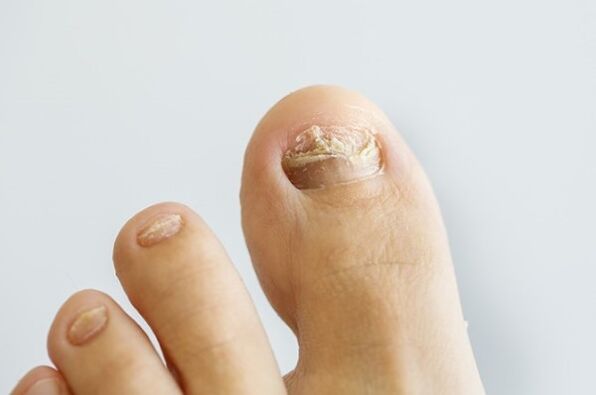
Causes of fungal nail damage
Fungal damage to legs in the legs in medical practice is much more common than a similar disease in the hands.This is due to the fact that the lower limbs are much more often in contact with the contaminated environment.In this case, the main cause of the occurrence is reduced immunity.The weakened organism is not able to completely support an infectious agent.
If we talk specifically about the fungus on the leg nails, there are several factors that contribute to the infection:
- Visiting public places without shoes.This is especially true for baths, saunas and swimming pools, showers in gyms or hospital departments in a hospital.In the first two cases, the risk of infection is high due to the participation of these places by people who have a fungal infection.In addition, mushrooms are multiplying more actively in a humid environment.Hospitals, despite compliance with sanitary standards, are a place of concentration of various infections, including fungi.Having become barefoot on the floor in one of these places, the likelihood of obtaining an infection grows ten times.
- In the absence of regular cleaning using aggressive chemistry, your own bath also becomes a seedling of fungal infection.Even though none of the households were sick with onychomycosis, conditionally pathogenic mushrooms that live on human skin multiply in the filthy bath.An increase in the population leads to deplorable consequences.
- Wearing old or other people, conditionally pathogenic mushrooms are on the skin, their entrance shoes (especially the closed type) are inevitable.Microorganisms accumulate in tissue layers, which also increases the risk of infection.
- Wearing shoes is not temperate - one of the infection factors is excessive leg perspiration.If a person enters closed shoes in summer or wears hot shoes in the living room, the likelihood of fungal damage increases.
- In violation of leg hygiene - many people do not pay due attention to the hygiene of the lower ends.However, the periodic nail cutting and the careless washing of the soap legs may not be enough.It is important to cut the nails regularly, cut the burrs and push the cuticles, use special lotions and constantly clean the keratinized layers of the skin.
- Wees - We are talking about damage to the nail plate on the fingers, injured, cuts.In such cases, blood circulation is disturbed in the damaged area, the nail does not receive the proper amount of nutrients.This can cause the development of the fungus.
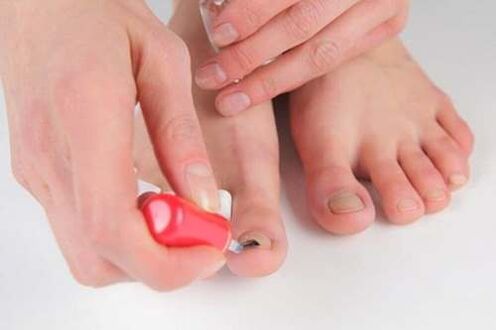
Types of mushrooms and nail damage characteristics in the legs
The characteristics of treatment depend on the identification of mushroom species that affect nail plate.This is due to the possibility of selecting medications that show activity in relation to a specific type of pathogen and the implementation of the most effective treatment.According to statistics, dermatophytes cause a nail fungus of about 75-80% of cases.It is in this case that the state of the immune system plays the main role in the occurrence of onychomycosis.With normal immunity, fungal damage to dermatophytes are almost impossible.
Infection comes from people or animals who are carriers, as well as in contact with the soil.Ceratinocytes, cellular structures of the epidermis, whose high content is observed in nails is a favorite medium of nutrition of this type of mushroom.
O tipo mais comum de patógeno. Segundo as estatísticas, os dermatófitos causam um fungo nas unhas de cerca de 75-80% dos casos. É nesse caso que o estado do sistema imunológico ocupa o principal papel na ocorrência de onicomicose. Com imunidade normal, os danos fúngicos aos dermatófitos são quase impossíveis.
A infecção vem de pessoas ou animais que são portadores, bem como em contato com o solo. Ceratinócitos, estruturas celulares da epiderme, cujo alto conteúdo é observado nas unhas é um meio favorito de nutrição desse tipo de cogumelo.
Two main subspecies are distinguished in the dermatophyte caste, most often aschomycosis pathogens:
- Red Tricophyte - The beginning of the pathological process occurs in the final (external or free) nail, from which the infection gradually moves to the root of the nail plate.In most cases, it is these subspecies that affect the toes.It is characterized by simultaneous nail damage at various fingers (usually stopped nearby).The characteristic signs of infection are the thickening of the affected area of the nail and its delamination.The skin under the outer facet of the dried nail plate and peelings.
- Trichophyton is inter -grade - in this case, white surface onychomycosis develops.The favorite habitat of subspecies is wet, is often found in baths, baths, pools.The causative agent most often affects the thumbs of the lower extremities, after which "captures" other nails.One feature is considered focal damage to the nail plate with the appearance of separate spots or white strips.In the future, whitish areas grow, merging.When fungal forms of life are spread to other fingers, areas of dry and peeled skin are found between the fingers.
Yeast
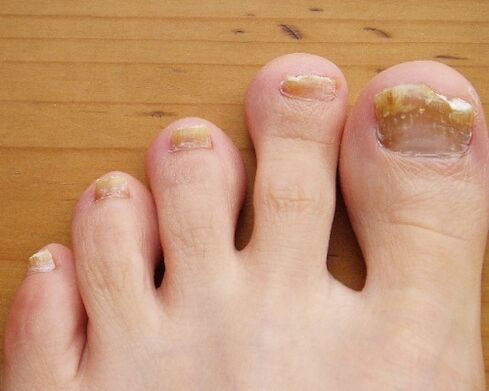
Another pathogen of fungal damage to the legs in the legs are conditionally pathogenic mushrooms of the Candida family.They are considered conventionally and pathogenic due to the fact that they constantly live on the surface of human skin.That is, for infection, contact with an infected person, animal or external environment does not need.In this case, the main trigger of pathology is a significant decrease in immunity, immunodeficiency.
Unlike dermatophytes, yeast mushrooms do not form a mycelium layer, ie the destruction of the nail plate with this form of damage occurs much less frequently.But the same factor makes the infectious lesion heavier, as the beginning of the pathological process assumes the root side (proximal) of the nail.Such varieties of ringworm are considered more serious but at the same time rare.
The first characteristic characteristic of the pathological process caused by yeast mushrooms is the detachment of the upper layer of the nail plate.For this reason, the nail loses its shine, becomes opaque and rough.Nail damage with yeast mushrooms occurs in about 7 to 10% of cases.
Molds
The most insidious type of mushrooms, since these life forms are found almost everywhere (but especially in a humid environment).Damage of nail fungal in the leg can cause about 35 to 40 subspecies of mold.
Despite the prevalence in the environment, this form of onychomycosis is rarely diagnosed.In part, therefore, as due to an atypical clinical picture, the mold is more difficult to diagnose and treat.Another reason for the complexity of mold onychomycosis diagnosis is the capume's ability to form mycelium, which makes the clinical picture a selection with damage to dermatophytes.
Fungal life forms mainly affect nails on the legs, and subspecies infection are about 10 to 15%.Progress slowly.In the early stages, the fungus can remain unnoticed.But there are still symptoms of the early stages of pathology development, which are important to pay attention:
A maioria dos tipos de dano de fungos nas placas das unhas progride lentamente. Nos estágios iniciais, o fungo pode permanecer despercebido. Mas ainda existem sintomas dos estágios iniciais do desenvolvimento da patologia, que são importantes para prestar atenção:
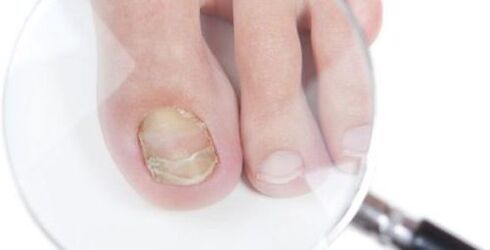
- Growth violation is the first and most discreet sign.In a state of norm, nail in the leg grows no more than 2 mm per week.The nail plate, affected by the fungus decreases the growth rate.
- Changing color - first and foremost, nails affected by fungus disappear, losing shine, becoming matte.It also observes the appearance of white or yellow interspersed on the surface of the nail or a complete change in the color of the nail plate (white, yellow or brown shades are possible).Changing the color of nail fungus in the picture above.
- The formation of burrs and cuticle damage is another indirect attribute that indicates the damage of the fungus of the nearby skin.If the burrs have begun to appear more often, and the cuticle area is systematically inflamed or damaged, it is worth checking if a fungal lesion.
- Thickening or thinning of nail plate - variations depend on the damage to specific types of mushrooms.
As the pathological process advances, symptoms are becoming more obvious, it is more difficult to ignore it.The clinical signs of the posterior stages of Onychomicosis include:
- Changing the surface of the nail plate - becomes rough and irregular, dotted with tubers and waves.Also on the nail, the similarities of crumbs may appear, which indicates a gradual detachment of the upper layer of the nail.
- In the still later stages, the nail gradually begins to collapse.Initially, this is expressed in the stratification of the nail plate, the appearance of cracks across the surface or chips on the outer edge.This is how this fungus feature on the leg nails in the photo looks like.
- In the future, destruction is even more serious.The nail literally collapsed, having no time to grow.At the same time, the subgear sections of the dermis are exposed and the remaining parts of the nail seem clearly painful and unattractive.As a result, there is a risk of complete destruction or detachment of the nail plate.Severe injury with a nail fungus in the picture above.
The danger of complications
Many unpleasant sensations and the deterioration of the appearance of leg nails are just the top of the iceberg.The lack of timely treatment threatens the development of complications, among which are considered the most common:
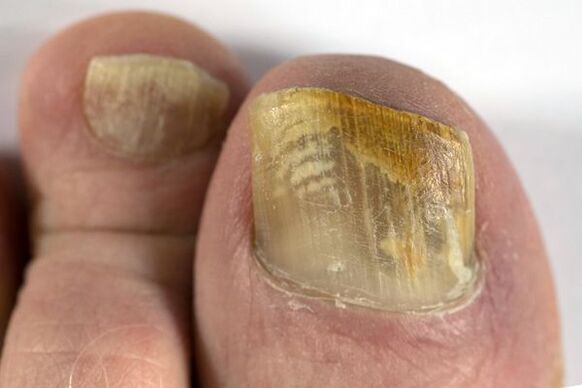
- Allergic reactions - at certain stages of development, leg fungus can be perceived by the body as an allergen.
- Fungal damage can weaken the body's immune system, cause the development or progression of various diseases, including systemic treatment.join other infections in the affected areas.As a result, inflammatory and purulent processes develop.
- Particularly serious cases, subject to prolonged course and disease progression, can lead to the development of fungal ringworm.In this case, fungal life forms can penetrate the blood and will be spaced throughout the body.
- Treatment methods
For maximum effectiveness of nail fungus treatment, complex therapy is often used.At the same time, it is previously important to make diagnoses sowing in a bacterial environment in order to determine the type of pathogen and choose the most effective medicines.An integrated approach involves the combination of various types of therapy, but sometimes this is not enough.
Medication
Drug Therapy is the basis for treating most pathologies, including fungal nail lesions.As part of treatment, two main groups of medicines are used, depending on the stage of development of the pathological process:
- Location type of action - Includes ointments, gels, varnishes, creams, sprays and lotions with antifungal activity.The method, multiplicity, and duration of use of such medications is determined by a doctor, but in most cases they are used at least 2-3 weeks.
- Systemic antimycotic - are required to treat fungus from nails in posterior progression stages.Most of the time, these are compressed, which, after sucking from the gastrointestinal tract, penetrate the blood and inhibit fungal forms of life, and also does not allow ringworm to spread.The use of systems is important not only to improve the therapeutic effect, but also with the goal of preventing relapse.
Popular Remedies

Traditional medicine is considered an auxiliary method to combat the fungus in the legs.Folk recipes may increase the antifungal effect.The most effective of them is considered:
- iodine - is able to dissolve protein structures, which are the basis of fungal life forms.For treatment daily, apply a few drops of iodine to the affected areas with a cotton pillow.
- Peroxide is an effective antibacterial agent that has an disinfectant effect.To improve the effect, peroxide is mixed in equal proportions with vinegar.Then the patient is lubricated with a mixture, it is not necessary to rinse.The procedure is repeated daily for 1-2 weeks.
- Celandine - The best method of using this plant for the treatment of fungal in the leg nails is the poultice.To do this, take a tablespoon of rainfalls (leaves and branches), pour 0.5 liters of water and boil.Decoction is defended in 15 to 20 minutes, after which the legs are plunged for another 20 to 25 minutes.Repeat the procedure daily before bed for 2-3 weeks.
Removing nail
Today, in medical practice, especially the chemical method of removing nail plate - the loose are used.For this, special aggressive drugs are used, the procedure is performed by a doctor to avoid harming healthy areas of the plate and skin.This method is painless and effective, and indications for its use are the absence of conservative treatment results or advanced cases of onicomycosis. Laser therapy
The procedure involves partial or complete removal of the nail plate.The choice of method depends on how deeply the fungus has penetrated the nail structure.During laser therapy, an intensive laser irradiation method is used.A special device is removed with nail fungal layers, after which follows an antifungal therapy course.
Full removal of the nail plate with a laser is required if the nail is completely affected by the fungus to the base.In this case, after removal, a dressing is applied to naked areas of the skin under which an ointment or cream with an antifungal effect can be placed.Removing the nail plate requires regular visits to the doctor to dress up and monitor the growth of the new nail plate.

Laser treatment of nail fungus on the legs, during which only a few layers of nail are removed, is performed in stages, within 7 to 10 procedures (about 10 to 15 minutes are required to process each nail).If the removal is shown, the procedure will disappear and take about 20 minutes, the patient feels no pain.
O tratamento a laser do fungo das unhas nas pernas, durante as quais apenas algumas camadas da unha são removidas, é realizada em estágios, dentro de 7 a 10 procedimentos (cerca de 10 a 15 minutos são necessários para processar cada unha). Se a remoção for mostrada, o procedimento desaparecerá e leva cerca de 20 minutos, o paciente não sente dor.

















